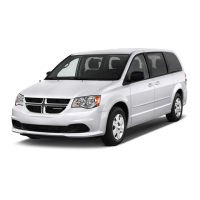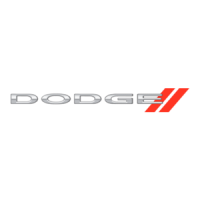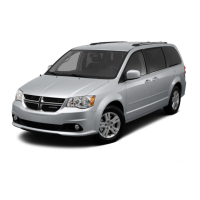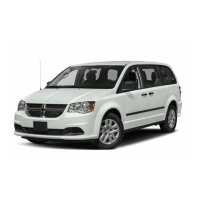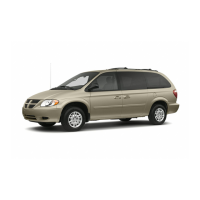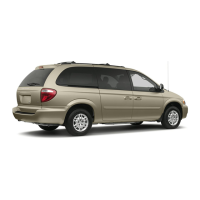
Do you have a question about the Dodge 2016 GRAND CARAVAN and is the answer not in the manual?
| Brand | Dodge |
|---|---|
| Model | 2016 GRAND CARAVAN |
| Category | Automobile |
| Language | English |
The Vehicle Identification Number (VIN) is found on the left front corner of the instrument panel, visible through the windshield.
Any modifications or alterations to this vehicle could seriously affect its roadworthiness and safety and may lead to a collision.
Your vehicle uses a keyless ignition system consisting of a Key Fob with Remote Keyless Entry (RKE) transmitter and a Wireless Ignition Node (WIN).
The Sentry Key Immobilizer system prevents unauthorized vehicle operation by disabling the engine.
Monitors vehicle doors for unauthorized entry and ignition switch for unauthorized operation.
Courtesy lights turn on when using the Remote Keyless Entry (RKE) transmitter to unlock doors or open any door.
Allows locking/unlocking doors and liftgate, and activating the Panic Alarm from a distance using the Key Fob.
Covers interior and exterior mirrors, including adjustment, automatic dimming, folding, and heated features for enhanced visibility.
Uses radar sensors to detect vehicles in blind spot zones and alerts the driver with visual and audible signals.
A voice-activated, hands-free communication system for dialing and managing calls using voice commands.
Details manual and power seat adjustments, lumbar support, heated seats, and head restraint positioning.
Allows programming and recalling driver seat, mirror, and radio settings via buttons or RKE transmitters.
Explains operation of headlight switch, automatic headlights, fog lights, interior lighting, and various indicator lights.
Covers intermittent wiper system, operation, mist feature, and rain sensing wipers for clear visibility.
Allows adjustment of the steering column's position (tilt and reach) for driver comfort and accessibility.
Provides a heating element in the steering wheel for comfort in cold weather with automatic shut-off.
System for maintaining a set vehicle speed, with functions like resume, accelerate, and deactivate.
Provides visual and audible warnings of detected obstacles when backing up, aiding parking maneuvers.
Details different overhead console options including lighting, storage, and controls for power sliding doors and liftgate.
HomeLink system for replacing up to three remote controls for operating garage doors, gates, and security systems.
Explains operation of the power sunroof, including express and manual modes, pinch protect, and venting features.
Information on 12 Volt power outlets for powering accessories, located in instrument panel and console.
Provides AC power for small electronic devices, converting DC current, located behind the second row seat.
Details the location and types of cupholders throughout the interior, including removable liners for cleaning.
Covers glove compartments, door trim panel storage, seatback storage, and second row seat storage bins.
Information on the rear window defroster and its operation.
Automatically maintains a level vehicle ride under various loading conditions using a hydraulic pump.
Instructions for deploying, using, and stowing crossbars for carrying cargo on the roof rack, with load limits.
Instructions for extending and retracting sun screens for rear seating windows, stored in sill trim panels.
An overview of the instrument panel layout, identifying key components like air vents, cluster, shift lever, radio, and controls.
Details the components of the base instrument cluster, including tachometer, speedometer, fuel gauge, and odometer display.
Explains the features of the premium instrument cluster, which includes more advanced displays and indicators.
A comprehensive guide to various warning and indicator lights on the instrument panel and their meanings.
Explains the driver-interactive display system and its menus for fuel economy, vehicle info, messages, and system setup.
Step-by-step instructions for safely starting the vehicle, including seat adjustment, mirror adjustment, and seatbelt fastening.
Information on using an engine block heater for easier starts in cold weather by warming the engine.
Details on operating the automatic transmission, including gear selection, shift interlock systems, and ECON mode.
Guidance on safe driving practices, acceleration, traction control, and hydroplaning on slippery road conditions.
Precautions and warnings for driving through water, including shallow and flowing water, and potential vehicle damage.
Information on the electric power steering system, its operation, and customizable settings via Uconnect.
Instructions on how to apply and release the foot-operated parking brake for securing the vehicle, especially on grades.
Details on the dual hydraulic brake systems, including ABS, EBD, BAS, and warning lights for system malfunction.
Explanation of advanced electronic systems like ABS, EBD, BAS, HSA, TCS, ESC, and ERM for enhanced vehicle stability.
Information on tire markings, identification, terminology, loading capacity, and pressure for safe vehicle operation.
Covers proper tire inflation, safety, economy, tread wear, and ride comfort, emphasizing the importance of correct pressure.
Guidelines for maintaining correct tire inflation for safe high-speed driving and load capacity.
Warning about combining tire types and the importance of using radial ply tires in sets of four.
Criteria for repairing tire damage, including puncture size and location, and warnings against sidewall damage.
Information on all-season tires and their identification, noting variations in traction levels.
Awareness about summer tires not being designed for winter conditions and the need for winter tires in cold weather.
Information on the capabilities and limitations of run flat tires, including the run flat mode and immediate replacement requirement.
Details about spare tires, including matching original equipment, compact spare tire usage, and warnings.
Warnings and precautions regarding spinning wheels when stuck in adverse conditions to prevent tire damage or failure.
How to use tread wear indicators to determine when tires should be replaced to maintain safety.
Factors affecting tire service life, including driving style, pressure, and the importance of replacing tires after six years.
Recommendations for selecting and inspecting replacement tires for optimal performance and safety, matching original specifications.
Guidelines for using traction devices, including clearance, size, installation, and recommended speed limits.
Benefits and methods of tire rotation for increasing tread life and maintaining traction and ride comfort.
Explains how the TPMS monitors tire pressure and provides warnings for low pressure or system malfunctions.
Information on using unleaded gasoline, E-85 fuel compatibility, and essential fuel system cautions.
Instructions on how to operate the hazard warning flashers for emergency signaling and visibility.
Steps to take to reduce overheating potential, including A/C operation, temperature control, and blower settings.
Information on using the tire service kit for sealing punctures and inflating tires, including components and precautions.
Specifies the correct torque values for lug nuts/bolts and torque patterns for proper wheel mounting.
Safety warnings and instructions for safely jacking the vehicle and changing a tire.
Techniques for freeing a stuck vehicle using a rocking motion, with cautions for transmission and engine.
Procedure for temporarily moving the shift lever if a malfunction prevents normal operation.
Guidelines for towing a disabled vehicle using a commercial towing service, covering different towing conditions and methods.
Identification of key components in the 3.6L engine compartment, including fluid reservoirs, filters, and battery.
Explanation of the OBD II system, its monitoring functions for emissions and engine performance, and MIL light behavior.
Information on emissions testing requirements and the readiness of the OBD II system for inspection.
Recommendation to use genuine MOPAR parts for maintenance and repairs to ensure optimal vehicle performance and warranty coverage.
Highlights the benefits of using an authorized dealer for service due to their expertise, special tools, and equipment.
Outlines the required maintenance services as determined by the vehicle's engineers, covering various systems.
Instructions on checking and changing engine oil, including recommended types, viscosity, and intervals.
Guidance on selecting and replacing the engine oil filter, recommending MOPAR filters.
Information on maintenance intervals for the engine air cleaner filter and its protective function.
Best practices for maintaining the exhaust system to prevent carbon monoxide entry and ensure proper function, including inspection for damage.
Information about the maintenance-free battery and its lack of periodic water addition or maintenance requirements.
Recommendations for checking and servicing the air conditioner for optimal performance, including condenser cleaning.
Guidance on lubricating locks, pivot points, hinges, and other components for quiet operation and corrosion protection.
Tips for cleaning wiper blades and windshield to maintain visibility and performance, and when to replace them.
Details on coolant checks, types, and the importance of proper maintenance for engine cooling and freeze protection.
Information on brake system inspection and maintenance, including fluid level checks, proper fluid types, and warning lights.
Information on the automatic oil change indicator system and how it notifies the driver for scheduled maintenance based on operating conditions.
A detailed schedule outlining required maintenance intervals for various services based on mileage or time passed.
Tips for preparing for service appointments, including having warranty papers, making a list of issues, and discussing charges.
Guidance on contacting the FCA US LLC Customer Center or FCA Canada Inc. Customer Center for assistance and information.
Information on special services and contact numbers available for hearing or speech impaired customers.
Details about purchased service contracts to protect against unexpected repair costs after the manufacturer's warranty expires.
References the Warranty Information Booklet for terms and provisions of FCA US LLC warranties applicable to the vehicle.
Recommends genuine MOPAR parts for maintenance and repairs to ensure optimal vehicle performance and longevity.
Instructions on how to report vehicle safety defects to NHTSA and the manufacturer, and how recalls are handled.


